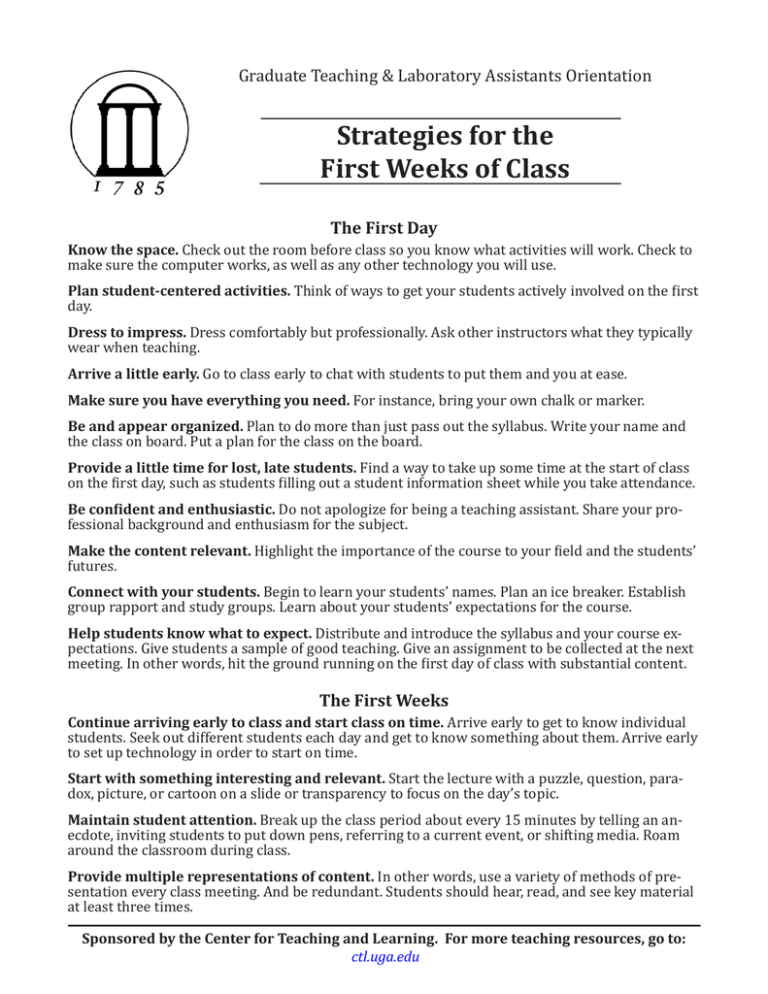First Weeks of Class - Center for Teaching and Learning
advertisement

Graduate Teaching & Laboratory Assistants Orientation Strategies for the First Weeks of Class The First Day Know the space. Check out the room before class so you know what activities will work. Check to make sure the computer works, as well as any other technology you will use. Plan student-centered activities. Think of ways to get your students actively involved on the first day. Dress to impress. Dress comfortably but professionally. Ask other instructors what they typically wear when teaching. Arrive a little early. Go to class early to chat with students to put them and you at ease. Make sure you have everything you need. For instance, bring your own chalk or marker. Be and appear organized. Plan to do more than just pass out the syllabus. Write your name and the class on board. Put a plan for the class on the board. Provide a little time for lost, late students. Find a way to take up some time at the start of class on the first day, such as students filling out a student information sheet while you take attendance. Be confident and enthusiastic. Do not apologize for being a teaching assistant. Share your professional background and enthusiasm for the subject. Make the content relevant. Highlight the importance of the course to your field and the students’ futures. Connect with your students. Begin to learn your students’ names. Plan an ice breaker. Establish group rapport and study groups. Learn about your students’ expectations for the course. Help students know what to expect. Distribute and introduce the syllabus and your course expectations. Give students a sample of good teaching. Give an assignment to be collected at the next meeting. In other words, hit the ground running on the first day of class with substantial content. The First Weeks Continue arriving early to class and start class on time. Arrive early to get to know individual students. Seek out different students each day and get to know something about them. Arrive early to set up technology in order to start on time. Start with something interesting and relevant. Start the lecture with a puzzle, question, paradox, picture, or cartoon on a slide or transparency to focus on the day’s topic. Maintain student attention. Break up the class period about every 15 minutes by telling an anecdote, inviting students to put down pens, referring to a current event, or shifting media. Roam around the classroom during class. Provide multiple representations of content. In other words, use a variety of methods of presentation every class meeting. And be redundant. Students should hear, read, and see key material at least three times. Sponsored by the Center for Teaching and Learning. For more teaching resources, go to: ctl.uga.edu The First Weeks (continued) Get your students actively involved in class. Elicit student questions and concerns at the beginning of class and list these on the chalkboard to be answered during the hour. Have the students write a one-minute paper about what they think the important issues or key points of the day’s lecture were. Check for their understanding and completion. Have students write questions on index cards to be collected and answered the next class period. Give students two passages of material containing alternative views to compare and contrast. Assign written paraphrases and summaries of difficult reading. Form a student panel to present alternative views of the same concept. Remind students about the relevance and importance of what they are learning. Tell about your current research interests and how you got there from your own beginnings in the discipline. Let your students see the enthusiasm you have for your subject and your love of learning. Provide sufficient wait time. When you ask your students a question, wait at least 5 seconds for a response. When you invite students to ask questions, you may need to wait even longer. Help students prepare for the first exam. Give sample test questions and answers. Have students anticipate test questions and answer those questions as a study method. Hand out study questions or study guides. After the First Month Conduct an informal “mid-term” course eval. Have students write instructional feedback to provide you with information about how they think and feel about the course. Consider asking the following four questions* and have students submit their answers anonymously: 1. 2. 3. 4. What does your instructor do that helps your learning? What does your instructor do that hinders your learning? What are you doing to help your learning? What can your instructor do for the rest of the semester to help your learning? Provide one or two concrete, specific suggestions. Read through your students’ responses and, during the next class, discuss what you are able to change and what you are unable to change and why. This provides an excellent opportunity to clarify course goals and to re-emphasize assignment expectations and the reasoning behind them. You can choose to repeat this at a later point in the semester as well. *Adapted from Angelo and Cross’s Classroom Assessment Techniques, 334. (1993). Suggested reading: Lang, J. M. (2008). On course: A week-by-week guide to your first semester of college teaching. Harvard University Press. Updated May 2012
